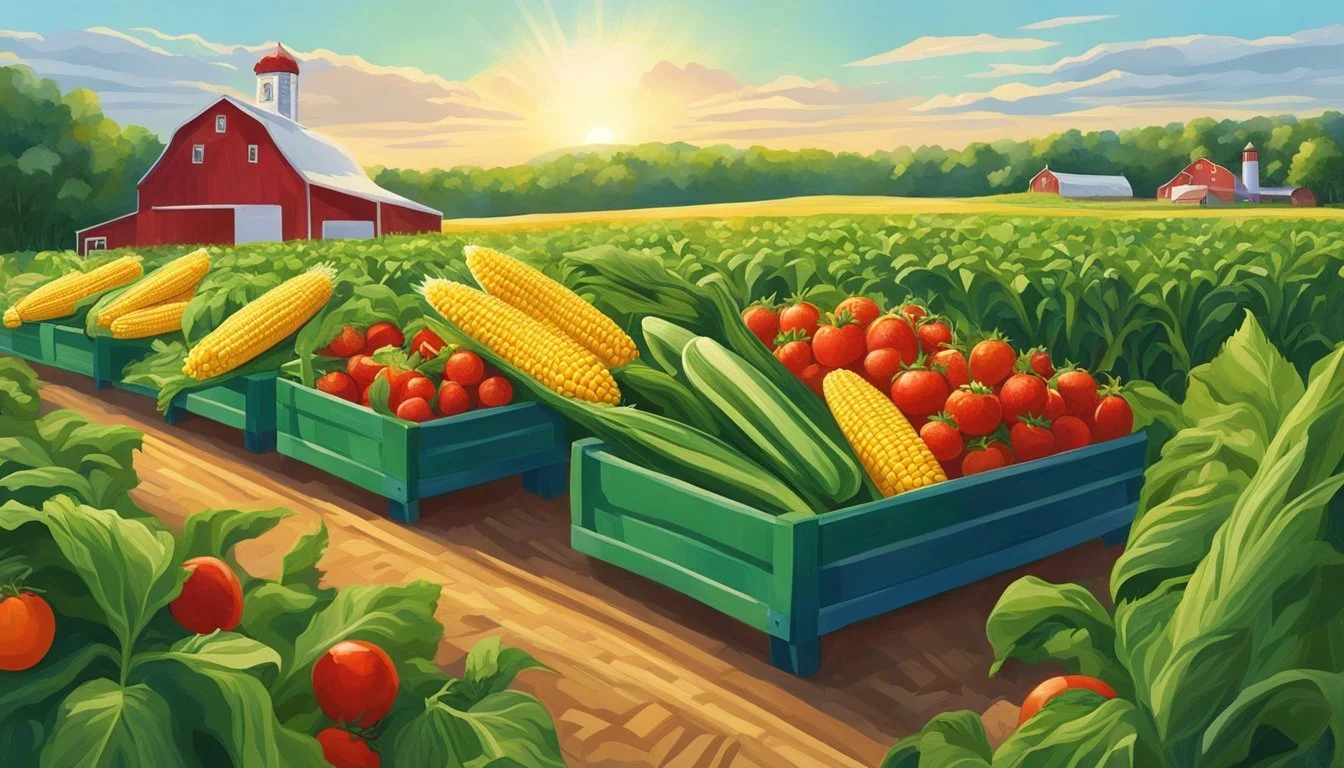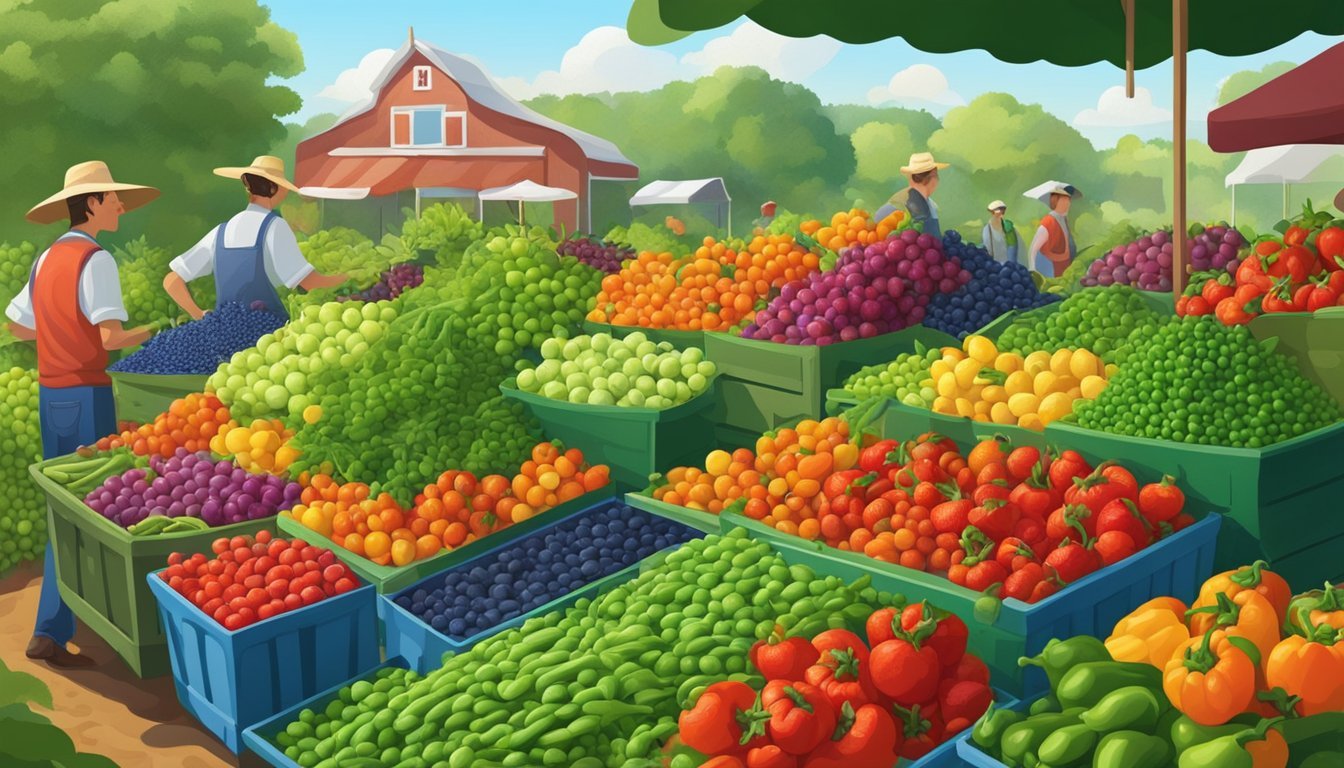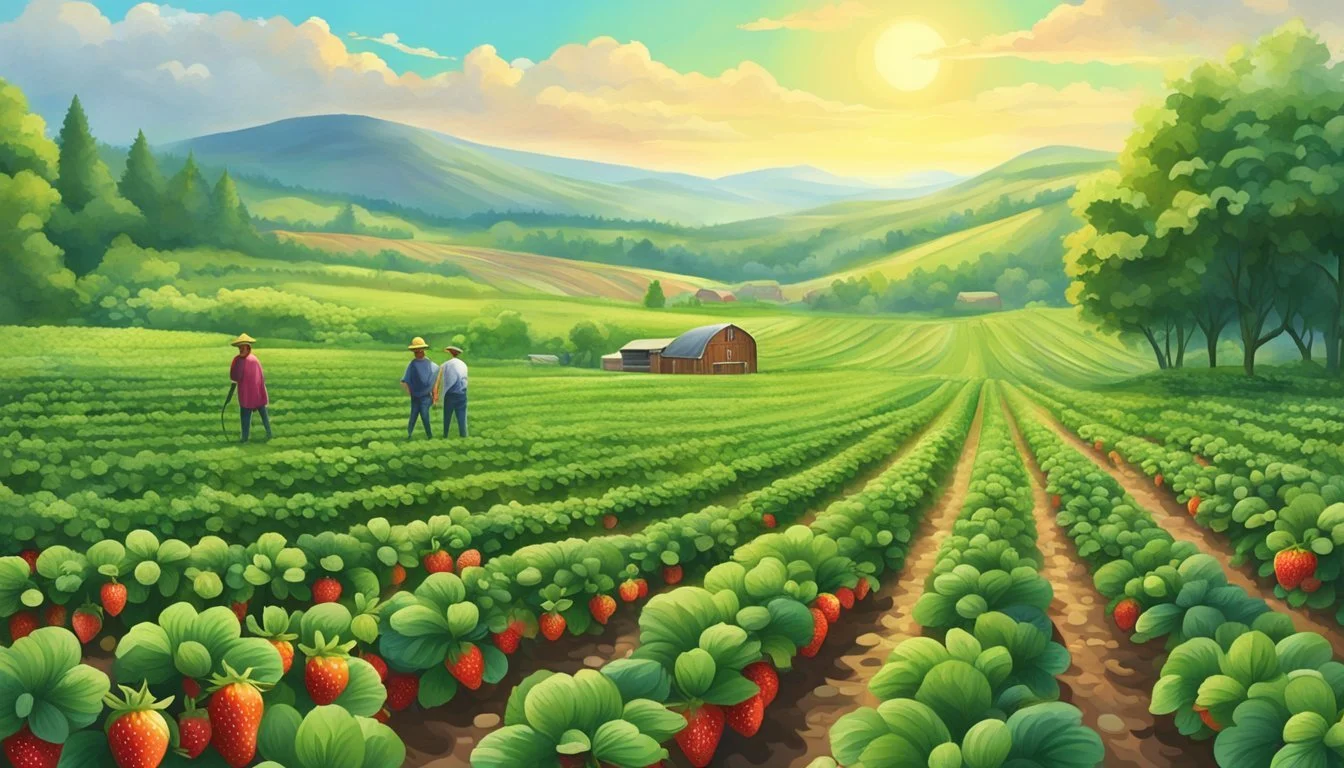Wisconsin Seasonal Fruit & Vegetables in July
A Guide to Fresh Produce
This Article is Part of our Wisconsin Seasonal Fruit & Veg Calendar
In the heart of the Midwestern United States, Wisconsin's climate and fertile soil yield a bounty of fresh fruits and vegetables, particularly in July. The warm summer month is an optimal time for both farmers and consumers to enjoy the peak of freshness from local produce. Berry enthusiasts relish in the availability of blueberries, which are harvested from early July through mid-August. Farms across the state offer a variety of blueberry types, and some, like the you-pick farms, invite visitors to harvest their own berries, providing both a flavorful experience and a connection to the source of their food.
July also ushers in a colorful assortment of vegetables. Leafy greens such as arugula and lettuces thrive in early summer and are joined by an array of other crops before the month's end. Carrots (how long do carrots last?), cucumbers, and sweet corn also make their anticipated entry into the market. These vegetables not only represent the seasonal rhythm of Wisconsin farming but also contribute to the local culinary landscape, finding their way into fresh salads, grill-outs, and summer feasts, celebrated for their crisp textures and vibrant tastes.
For those inclined towards sweeter flavors, melons begin to sweeten the palate during July's sunny days. This season is a period of plentiful agricultural offerings in Wisconsin, where local produce reaches its peak, capturing the essence of summer on the palate. Residents and visitors alike are encouraged to indulge in the fresh, locally-grown produce that embodies the season's generous harvest.
The Significance of July in Wisconsin's Agricultural Calendar
July stands at the heart of Wisconsin's agricultural calendar, marking the zenith of the growing season. During this period, the state's farms burst forth with fresh produce, offering a rich harvest that is eagerly anticipated by both markets and tables across the region.
Peak Growing Season
In July, Wisconsin's fields are in full bloom, with longer days and warmer temperatures creating ideal conditions for crop growth. This month is critical for farmers as they tend to their land with care, ensuring that the produce reaches its peak in flavor and nutrition.
Vegetables: Harvest time arrives for a variety of vegetables, including:
Vegetables Harvest Status in July Beets Peaking in availability Broccoli (how long does broccoli last?)Prime harvest time Cabbage Abundant harvest Carrots Readily available Cauliflower In season Cucumbers Peak season Sweet Corn Begins its prime season
Fruits: Several fruits also reach their optimal harvest period:
Fruits Harvest Status in July Cherries (how long do cherries last?) Especially the tart Montmorency variety Berries Various types including raspberries and blueberries
Palate of the Summer
As the summer's harvest progresses, Wisconsin's agricultural produce transforms the local palate. Farmers markets and roadside stands showcase the bounty of the season, featuring an array of colorful, fresh, and locally grown fruits and vegetables. The summer harvest brings a distinctive taste of Wisconsin to the forefront, one that is appreciated by chefs, home cooks, and food enthusiasts alike.
Seasonal Fruits in Wisconsin during July
July marks the peak season for a variety of fruits in Wisconsin. Farmers and consumers alike revel in the bounty of fresh, locally-grown produce available.
Enjoying Berries
Strawberries typically wind down in early July, but there's a wonderful transition to other berries. Blueberries and Raspberries hit their stride this month, presenting a fresh option for both snacking and baking. Farms across Wisconsin offer these berries, often featuring pick-your-own experiences that entice both locals and visitors.
Strawberries: Early July
Blueberries: Early July to mid-August
Raspberries: July
Stone Fruits Availability
Cherries are a notable stone fruit that comes into season in July. Wisconsin's Door County is famously known for its cherry orchards, where the fruit can be picked fresh or purchased at local markets.
Cherries: July
Visitors can enjoy these fruits in their freshest form, embracing the peak of natural flavor that Wisconsin has to offer during this time.
Seasonal Vegetables in Wisconsin during July
July in Wisconsin offers a rich tapestry of vegetables ripe for the picking. From the bounty of leafy greens to the vibrant root vegetables and squashes, the month's harvest is diverse and plentiful.
Leafy Greens and Herbs
Wisconsin's soil and climate in July are ideal for growing a variety of leafy greens and herbs. Lettuce and spinach thrive during this time, providing crisp, cool flavors perfect for summer salads. Herbs like basil and cilantro are at their peak, offering fresh aromatics for culinary uses.
Lettuce (various types)
Spinach
Herbs:
Basil
Cilantro
Root Vegetables and Squashes
The warm July weather supports the growth of several root vegetables and squashes. Zucchini and summer squash are stars of the season, both known for their versatility in dishes. Expect to see beans and cucumbers in abundance, great for both fresh eating and preservation.
Zucchini
Summer Squash
Beans (Green and other varieties)
Cucumbers
Local Markets and Farm Stands
July in Wisconsin showcases an array of local markets and farm stands, brimming with seasonal produce that connects consumers directly with the source of their food. These venues offer a distinct farm to table experience, promoting a cycle of support for local farmers and artisans.
Farm to Table Experience
Patrons visiting Wisconsin's farm stands in July can expect to indulge in the freshest, locally-grown fruits and vegetables. Each farm offers a unique snapshot of the region's agricultural prowess. These stands often feature a wide selection of in-season produce, from succulent strawberries to crisp lettuces, and they frequently operate on a near year-round basis, extending beyond just the summer months.
Farmers Markets: A Hub for Seasonal Produce
Farmers markets in Wisconsin serve as a central hub for seasonal produce, where local farmers converge to offer their freshest goods. Shoppers have the opportunity to explore a variety of stalls, each representing different farms and products. In July, these markets not only showcase summer favorites like tomatoes and berries, but they also host artisans and prepared food vendors, making them a cornerstone for community interaction and local commerce.
Health Benefits and Culinary Uses
In July, Wisconsin bursts with a bounty of fruits and vegetables that offer a wealth of health benefits and culinary possibilities. The fresh produce provides a nutritional advantage, and a culinary versatility stretching from raw salads to sweet compotes.
Nutritional Advantages of Seasonal Eating
Fresh produce in July includes broccoli, carrots, cauliflower, and various berries - each bursting with vitamins and minerals. For instance, broccoli is not only high in fiber but also rich in vitamin C and K, essential for bone health and immune function. Carrots, packed with beta-carotene, support eye health. Culinary applications are diverse, with salads and cooked dishes benefiting from the vibrant, fresh flavors and nutrients at their peak.
Broccoli: High in vitamins C, K, and fiber
Carrots: Rich in beta-carotene and antioxidants
From Salads to Compotes
July's cantaloupes (how long does cantaloupe last?) and berries are perfect for a fresh salad or transforming into a compote. A ripe, juicy cantaloupe, with its high water content and sweet flavor, makes a refreshing salad when paired with fresh greens or as a standalone dish garnished with mint. Berries, with their balance of sweetness and acidity, can be simmered down into compotes that accompany desserts or breakfast dishes. These preparations underscore the versatility of July's produce.
Salads: Cantaloupe pieces with mint, berry medleys
Compotes: Berry compotes as toppings for desserts or yogurts
The produce of the season is not only a treat for the palate but also a boost for one's health, giving people the chance to cook and eat with both enjoyment and well-being in mind.
Agricultural Practices and Weather Impact
In Wisconsin, the marriage of sustainable farming practices and an understanding of local weather conditions is key to a successful harvest in July.
Sustainable Farming Techniques
Farmers across the state of Wisconsin implement a variety of sustainable practices. These techniques help mitigate environmental impact and improve crop resilience. Examples of these practices include:
Crop Rotation: Rotating crops to avoid depleting the soil of nutrients and to disrupt pest and disease cycles.
Cover Cropping: Planting cover crops such as rye or clover to reduce erosion, improve soil health, and fix atmospheric nitrogen.
Integrated Pest Management (IPM): Combining biological, cultural, physical, and chemical tools in a way that minimizes economic, health, and environmental risks.
Influence of Weather Conditions
Weather conditions play a pivotal role in the success of Wisconsin’s agricultural output, especially in July when many fruits and vegetables reach their peak. Specific weather impacts include:
Temperature: Ideal temperatures can promote plant growth while extreme heat can stress plants, reducing yield.
Precipitation: Both its abundance and scarcity impact water availability. Excessive rainfall can lead to erosion and crop disease, whereas drought can stunt growth and decrease yield.
Extreme Weather Events: Storms and hail can cause immediate and severe damage to crops.
Farmers must remain vigilant, as the local climate directly influences the variability in crop production.
Engaging with Wisconsin's Farming Community
July in Wisconsin offers an opportunity for individuals and families to interact closely with the local farming community. Through educational initiatives and social media engagement, they can gain a deeper understanding of seasonal produce and the agricultural processes.
Educational Farm Tours
Farm tours in July allow visitors to experience the harvest of vibrant Wisconsin produce firsthand. They can learn about the various stages of farming from planting to harvesting. Many farms in Wisconsin offer guided tours where experts explain the intricacies of cultivating crops like cherries in Door County. Visitors often have the chance to participate in pick-your-own activities, particularly in orchards that are ripe with cherries during this month.
Social Media Connections
Social media platforms like Facebook, Twitter, and Pinterest serve as vital channels for farms to share updates and connect with the community. They post about the current harvest, available produce, and upcoming events. Interested individuals can follow their favorite farms to stay informed about the latest educational programs and community events. Social media also enables farms to share tips about how to select and prepare seasonal fruits and vegetables, contributing to the community's knowledge and appreciation of local agriculture.
Planning and Preservation Techniques
In July, Wisconsin offers an abundance of seasonal produce ripe for harvest. Successfully preserving these fruits and vegetables ensures flavorful, nutritious options throughout the winter months. The following techniques are foundational for maintaining food quality and extending the enjoyment of July's harvest.
Canning and Freezing for Winter
Canning allows for the safe preservation of peak-season tomatoes, which can be a fun and rewarding process. To ensure safety and quality, following research-tested guidelines is crucial. Summer fruits like blueberries, picked especially in early July, can be canned as jams, jellies, or whole fruits.
Essential Supplies:
Canning jars with two-part lids
Large canning pot with rack
Jar tongs and funnel
A reliable, research-based canning guide
For tomatoes, it's important to add lemon juice or citric acid (how long does citric acid last?) to lower the pH and ensure safety. When canning blueberries, they should be packed in water or natural juices to retain flavor and prevent browning.
Freezing is another excellent preservation method that retains nutritional value. Blueberries freeze particularly well, and the technique is straightforward: wash, pat dry, and place in a single layer on a baking sheet before transferring to freezer bags or containers.
Preservation Tips:
Blanch vegetables like green beans and spinach before freezing.
Use airtight containers or bags to prevent freezer burn.
Label with the date of freezing to keep track of the freshness.
Crop Rotation and Seasonal Planning
Crop rotation enhances soil health and helps prevent pest infestations. For a Wisconsin gardener planting in July, potatoes, carrots, and root vegetables are suitable choices for the fall garden. Potatoes planted in July will be ready for harvest in the fall, and an optimal rotation scheme can ensure a steady yield.
Rotational Planning Steps:
Identify previous crops grown and rotate with non-related species.
Plan for space requirements and companion planting benefits.
Monitor crop progress and adjust future plantings based on performance.
Seasonal planning involves understanding the availability of different crops and their optimal planting times. Knowing that items like lettuce and spinach thrive in the cooler temps of June and early July can inform preservation strategies and ensure a consistent flow of produce.
Key Considerations:
Determine which crops have multiple harvests per season (e.g., lettuce).
Adjust planting schedules based on the Wisconsin Produce Calendar.
Harvest at peak ripeness for maximum flavor and preservation quality.
Through canning, freezing, crop rotation, and seasonal planning, one can maximize the usage of Wisconsin's bountiful July produce and guarantee nutrient-dense food throughout winter. These techniques are foundational for any gardener or cook aiming to capitalize on the season’s offerings.









